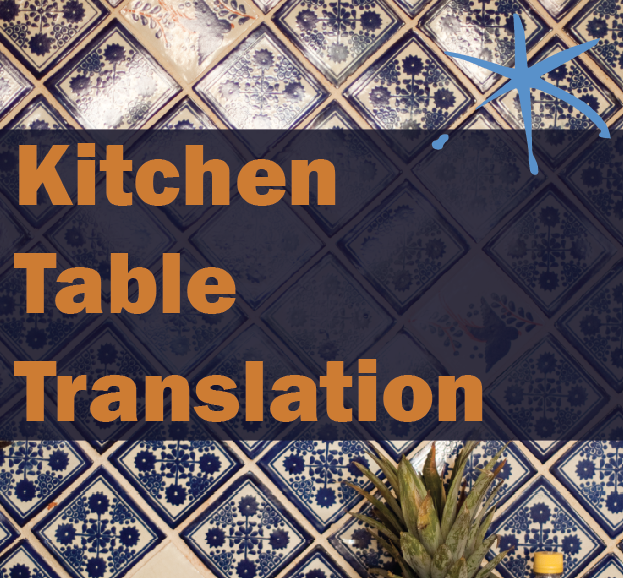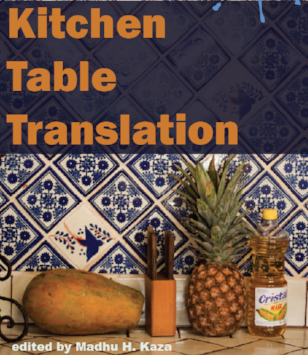
A few years ago the translator Bill Martin invited me to participate in The Bridge Series, which produced regular events in New York City devoted to literary translation. Though I was grateful to be asked, I balked. The invitation brought to surface many of my anxieties around translation. Although I had published translations at that point, I did not feel comfortable talking about this work in the literary milieu of New York.
At some point I began to understand that my discomfort with translation was connected to the trauma of immigration. Something went quiet in me when I was brought to the U.S from India as a child. Although I assimilated and lost my accent, a vital part of me got stopped at the border. My inner life remained untranslated, its contours beyond what the receiving culture wanted to or could comprehend. As an immigrant child I felt an aura of illegitimacy about my claim to be an American. At times I lived with radical insecurity. As an adult, when I translated from Telugu, my first language (which I’d learned to read in college), I experienced a repetition of the loss I’d felt as a child. I not only worried about my own distance from the language but also wondered how the text I was translating would be received in the U.S., whether and on what terms it would belong. Translators often speak about the impossibility of their work, the untranslatability of particular words and texts from one language to another. What does it mean to be a translated self, I wondered? What does it mean to live with this untranslatability, this silence between languages within you?
Kitchen Table Translation extends from this personal experience to a greater curiosity about how immigrants, children of immigrants, or people who identify as part of a diaspora might bring a particular set of concerns to the task of translation distinct from the mainstream of literary translation in the United States. When the movement of texts (translation) is linked with the movement of bodies (migration), issues of language and culture necessarily collide with questions about politics, history, race and imperialism—the very contexts of migration and diaspora. Both in the Kitchen Table Translation events I curated and in this issue of Aster(ix), I wanted to hear from writers and translators who could speak about personal, cultural and political dimensions of translation in relation to the technical and aesthetic aspects of the work.
The world of literary translation in the U.S. is largely white, and Kitchen Table Translation mostly features people of color. However, the primary impulse of this issue is not “diversity” or “inclusion”— terms which in the literary world can be impediments to rigorous and critical conversations about literary values. To be sure, Kitchen Table Translation invokes Kitchen Table Press, the feminist, women of color press founded by Barbara Smith and Audre Lorde together with a collective of radical women of color. Instead of seeking admission into the existing literary institutions, they forged new possibilities and built new structures, creating the first woman of color press in the United States. Their groundbreaking work changed the terrain of (deterritorialized) American literature. It is a meaningful connection to me that whomever is included in its pages, Aster(ix) is a journal run by women of color.
People of color, then, are not a bonus to be added to the regularly scheduled literary programming. I see Kitchen Table Translation’s contributors not as a representative group and not in terms of a congratulatory diversity, but in terms of difference. They do not necessarily share a particular approach to translation or the same literary taste. Nor do they all equally identify as immigrant or diasporic subjects. But I’m interested in the particular intelligence of each of these various writers and how they open up problems and possibilities for literary translation.
When it is even acknowledged, much of literary translation in the U.S., especially of prose, is appraised in terms of fluency, which often coincides with ideas of accessibility and seamlessness. A fluent translation avoids literalism and awkwardness (translatese); the wrinkles that would remind us that it is translation are ironed out. There is an emphasis on the translator’s mastery of language and an artfully inconspicuous technique. Whereas in most parts of the world— particularly in post-colonial contexts—translation is recognized as inherently political, discussions of literary translation in the U.S. emphasize formal concerns with a light attention to cultural variance.
How might we think through these values? What are questions we might ask? There are the questions of what gets translated and why. And then how? If fidelity and submission to the original are marks of a good translation, how might errant, disobedient translation serve us? If fluency and domestication are prized, what might a translation that reminds us of the text’s foreignness offer? Translation can function politically in a range of ways. Translation theorist Lawrence Venuti argues that the Anglo-American emphasis on fluency “enacts an ethnocentric violence.” In this sense, fluency can be compatible with multicultural and cosmopolitan celebrations of translation that nevertheless do not seek to interrogate the dominant culture or its existing norms, and which are only superficially interested in difference. Translation can also perform subtle acts of critical resistance by introducing texts into the English language that speak from marginalized voices and values, or through modes of translation that do not seek to erase the otherness of the text.
Kitchen Table Translation seeks to make space for the fact that translation can be an intimate act, and many of us use our translation skills in non-professional as well as professional capacities. Some of us, when we translate, call on our family (rather than colleagues) to help us with challenging passages or words. Some second generation, diasporic and indigenous writers who speak (or partly speak) an ancestral language at home might find the discourse of mastery fraught, especially when access to a language has been lost through historical violence and dislocation. And some of us experience translation all the time in our bodies, names, homes, movements and daily lives even if we are not translating from one text to another.
Personal experiences of otherness can potentially lend creative and critical charge to the work of translation. In Kitchen Table Translation, Sony Coráñez Bolton’s essay offers one possibility of a decolonizing translation practice that draws from Gloria Anzaldúa’s queer, borderland, Chicana feminism and critiques the ideal of mastery from the perspective of disability studies. Don Mee Choi presents translation as one response to U.S. imperialism and the pain of migration. Lina Mounzer invokes American hegemony in her recognition that the English language is not neutral in relation to Arab worlds.
Writers like Zohra Saed and Gabrielle Civil connect translation directly to family history; In Saed’s account of her work with Langston Hughes’ archive, translation is a genealogical archeology that must accommodate the fissures and silences of history. Civil’s performance score not only amplifies translation errors but also uses moments of failure to contest the strictures of translation in the academy.
Amy Sara Carroll’s poems are part of the Transborder Immigrant Tool, a project which provides navigational and safety assistance for migrants crossing the desert between Mexico and the United States through an app for flip phones. The poems, translated collaboratively and published under a Creative Commons license, engage a translation ecology in which authorial autonomy is de-stabilized and translation itself becomes a continual crossing by many different translators across a landscape.
Eiko Otake, who is primarily known as a movement artist (half of the duo, Eiko & Koma), has translated a book that stands apart from much of contemporary Japanese literature in translation: Nagasaki survivor Kyoko Hayashi’s travelogue of her pilgrimage to the White Sands nuclear test site in New Mexico. Hayashi’s book, a work of profound witnessing and empathy, evokes questions about war and peace, suffering and the environment. It’s a book that Eiko urgently felt needed to be read by American readers, especially in the aftermath of 9/11. In her introduction to the book-length translation, Eiko reflects not only on her choice of text, but also her approach to the ethics of translation: “I decided . . . that I should risk awkwardness in English. Hayashi’s voice came from her body, and it should stay connected to her body. I did not want Hayashi’s work to be translated into such smooth English that it could be read as if an American woman were writing.” Dagmawi Woubshet similarly maintains the poignant jaggedness of the fledgling style of the children, Ethiopian AIDS orphans, whose letters to their dead parents he translated. These translations draw our attention to the subjectivity of individuals (whom he calls the disprized) whom we mostly only encounter in the U.S in reductive, generalized terms of African otherness.
In a lecture given at the American University in Cairo, the Iraqi born writer and translator, Sinan Antoon spoke movingly of translation as an act of mourning. Psychotherapist, poet and translator, Genya Turovskaya, whose family fled the Soviet Union when she was a child, has described her return to the Russian language through translation as the repairing of a wound. In Kitchen Table Translation, multiple, overlapping and sometimes conflicting notions of translation live together: translation is conceived of as a mediation between personal, family and political history; a summoning of spirits, a transplantation— of seeds, of organs; a return from light into darkness (where migration is the movement from darkness to light, though these terms do not carry their conventional values); a gesture of solidarity, a flight of shadows, an act of decolonization, an entrance into afterlife, a bodily transfiguration, the border crossings of language, an experience of inter-subjectivity, the closest possible reading.
For me, with all its predicaments, all the violence it may carry on its back, translation is an act of hospitality. Hospitality, conceived not as charity, not as condescension or even merely tolerance. A hospitality that recognizes both the dignity and the difference of the other. In this model, translation is not about assimilation—of the other language or the other body. The impossibility of any particular translation is not a difficulty to be overcome, just as the difference of an immigrant, a refugee, or anyone deemed other is not a difference to be overcome, but rather greeted with care. Translation can be a practice of hospitality that acknowledges that the host, too, will have to be changed by the encounter. We may unravel and have to remake ourselves with others. This is not a simple task that can be celebrated in the usual glib ways, but it is beautiful and worthwhile. In the words of Youmna Chlala:
First, we had to learn each other’s languages.
This was the longest, most loving trial.
Then we undid our own.

Madhu Kaza was born in Andhra Pradesh, India and grew up in Detroit, Michigan. She is currently an educator, writer and artist based in New York. Much of her work is informed by her astonishment at everyday life.







